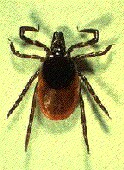- Skip Storing This Everyday Product in the Fridge Door
- Green Tea + B3 Pairing May Boost Brain Health
- Navigating Your Midlife Crisis: Embracing New Possibilities
- City Raccoons Showing Signs of Domestication
- Mapping the Exposome: Science Broadens Focus to Environmental Disease Triggers
- One Week Less on Social Media Linked to Better Mental Health
- Your Brain Changes in Stages as You Age, Study Finds
- Some Suicide Victims Show No Typical Warning Signs, Study Finds
- ByHeart Formula Faces Lawsuits After Babies Sickened With Botulism
- Switch to Vegan Diet Could Cut Your Greenhouse Gas Emissions in Half
Another Tick-Borne Illness Documented in Northeast


The same ticks that spread Lyme disease may also carry a rarer bacteria that’s causing serious illness in the northeastern United States.
Like Lyme disease, Borrelia miyamotoi disease causes flu-like symptoms such as headache, fever, chills and muscle pain. But at its most severe, it can lead to a serious brain infection — meningoencephalitis, researchers say.
And nearly one-quarter of patients treated for the disease require hospitalization, a new study suggests.
“This is an emerging infection and a lot of people and doctors have not heard about it,” said lead researcher Dr. Philip Molloy, medical director of Imugen Inc., a Norwood, Mass.-based company that develops blood tests for tick-borne diseases. Imugen funded the new study.
Fortunately, B. miyamotoi disease (BMD) can be treated with the same antibiotics used to treat Lyme disease, experts said.
How many people actually have BMD is not known. Since most doctors aren’t looking for it, patients with symptoms may be tested for Lyme disease, but these tests are negative, Molloy said.
Also, it’s probable that people get BMD but never see a doctor. “Undoubtedly, there are milder cases out there,” he said.
Hoping to learn more about this emerging threat, Molloy’s team reviewed 51 out of 97 BMD infections identified from thousands of blood samples taken in 2013 and 2014.
When identified in Japan in 1994, BMD was thought not to harm humans. The first human cases were reported in Russia in 2011. The first case in the northeastern United States was seen in 2013, Molloy said.
The new report was published June 9 online in the Annals of Internal Medicine.
The tick that spreads BMD is the tiny, hard-bodied deer tick (Ixodes scapularis). These ticks carry six germs that can infect humans, said Dr. Peter Krause, a senior research scientist at the Yale School of Public Health and a co-author of an accompanying journal editorial.
Krause said the best way to avoid getting BMD or any tick-borne disease is to check yourself for ticks after being in grassy areas, where ticks are likely to live.
Usually a tick has to remain attached to your skin for about 24 hours for a germ to enter your bloodstream, Molloy said. “It’s not just casual contact with ticks,” he said.
A recurring fever is a hallmark of the infection. If treated early, the fever does not return. A rash is seen in fewer than 10 percent of patients, as opposed to 90 percent of people infected with Lyme disease, he said.
“The peak of BMD appears to be August,” he said. “That’s a month later than Lyme disease.” This difference is due to the life cycle of the tick, which spreads different diseases at different times, Krause explained.
Many patients have probably been misdiagnosed and treated incorrectly, he said. “Until recently, no one was even looking for BMD in this country,” Krause said. “We know now it’s in this country and it has probably been here for a long time.”
More information
For more on Borrelia miyamotoi disease, visit the U.S. Centers for Disease Control and Prevention.
Source: HealthDay
Copyright © 2025 HealthDay. All rights reserved.










